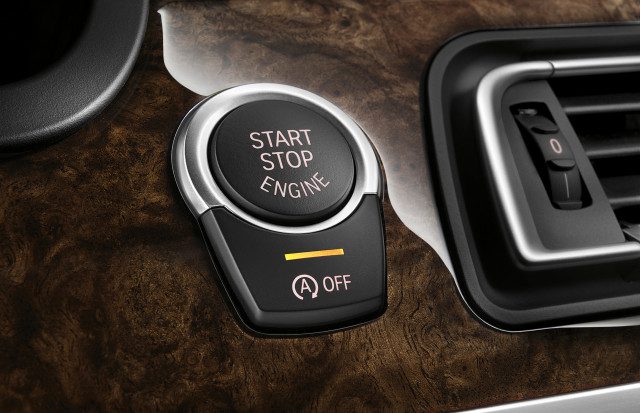
The device and principle of operation of the "start-stop" system
Content
In large cities, traffic congestion has become a part of the everyday life of motorists. While the car is in a traffic jam, the engine continues to idle and consume fuel. To reduce fuel consumption and emissions, automotive developers have created a new "start-stop" system. Manufacturers unanimously speak about the benefits of this function. In fact, the system has many disadvantages.
The history of the start-stop system
In the face of rising prices for gasoline and diesel, the issue of saving fuel and reducing consumption remains relevant for most motorists. At the same time, movement in the city is always associated with regular stops at traffic lights, often with waiting in traffic jams. Statistics say: the engine of any car runs idle up to 30% of the time. At the same time, fuel consumption and the emission of harmful substances into the atmosphere continue. The challenge for automakers is to try to solve this problem.
The first developments to optimize the operation of automobile engines were started by Toyota in the mid-70s of the last century. As an experiment, the manufacturer began to install a mechanism on one of its models that turns off the motor after two minutes of inactivity. But the system didn't catch on.
A few decades later, the French concern Citroen put into operation a new Start Stop device, which gradually began to be installed on production cars. At first, only vehicles with a hybrid engine were equipped with them, but then they began to be used in cars with a conventional engine.
The most significant results were achieved by Bosh. The start-stop system created by this manufacturer is the simplest and most reliable. Today it is installed on their cars by Volkswagen, BMW and Audi. The creators of the mechanism claim that the device can reduce fuel consumption by 8%. However, the real figures are much lower: in the course of experiments it was found that fuel consumption is reduced by only 4% in the conditions of everyday urban use.
Many automakers have also created their own unique stop and start mechanisms for the engine. These include systems:
- ISG (Idle Stop & Go) от Kia;
- STARS (Starter Alternator Reversible System), installed on Mercedes and Citroen cars;
- SISS (Smart Idle Stop System) developed by Mazda.
Principle of operation of the device
The main task of the "start-stop" system is to reduce fuel consumption, noise level and emission of harmful substances into the atmosphere while the engine is idling. For these purposes, an automatic engine shutdown is provided. A signal for this can be:
- complete stop of the vehicle;
- neutral position of the gear selection lever and release of the clutch pedal (for cars with manual transmission);
- pressing the brake pedal (for vehicles with automatic transmission).
While the engine is shut down, all vehicle electronics are powered by the battery.
After restarting the engine, the car starts quietly and continues the journey.
- In vehicles with a manual transmission, the mechanism starts the engine when the clutch pedal is depressed.
- The engine in cars with automatic transmission starts working again after the driver takes his foot off the brake pedal.
The device of the "start-stop" mechanism
The design of the "start-stop" system consists of an electronic control and a device that provides multiple starting of the internal combustion engine. The latter are most often used:
- reinforced starter;
- reversible generator (starter-generator).
For example, Bosh's start-stop system uses a special long-life starter. The device is originally designed for a large number of ICE starts and is equipped with a reinforced drive mechanism, which ensures reliable, fast and quiet engine start.
The tasks of e-government include:
- timely stop and start of the engine;
- constant monitoring of the battery charge.
Structurally, the system consists of sensors, a control unit and actuators. The devices that send signals to the control unit include sensors:
- wheel rotation;
- crankshaft revolutions;
- pressing the brake or clutch pedal;
- neutral position in the gearbox (only for manual transmission);
- battery charge, etc.
The engine control unit with the software installed in the start-stop system is used as a device that receives the signals from the sensors. The roles of the executive mechanisms are performed by:
- injection system injectors;
- ignition coils;
- starter.
You can enable and disable the start-stop system using the button located on the instrument panel or in the vehicle settings. However, if the battery charge is insufficient, the mechanism will be disabled automatically. As soon as the battery is charged to the correct amount, the engine start and stop system will start working again.
"Start-stop" with recuperation
The most recent development is the start-stop system with energy recovery during braking. With a heavy load on the internal combustion engine, the generator is turned off to save fuel. At the moment of braking, the mechanism begins to work again, as a result of which the battery is charged. This is how energy is recovered.
A distinctive feature of such systems is the use of a reversible generator, which is also capable of operating as a starter.
The regenerative start-stop system can work when the battery charge is at least 75%.
Weaknesses of development
Despite the obvious advantages of using the "start-stop" system, the mechanism has important drawbacks that should be taken into account by car owners.
- Heavy load on the battery. Modern cars are equipped with a huge number of electronic devices, for the operation of which, when the engine is stopped, the battery must be responsible. Such a heavy load does not benefit the battery and quickly destroys it.
- Harm to turbocharged engines. Regular abrupt shutdown of the engine with a heated turbine is unacceptable. Despite the fact that modern cars with turbines are equipped with ball-bearing turbochargers, they only reduce the risk of turbine overheating when the engine is suddenly turned off, but do not completely eliminate it. Therefore, it is better for the owners of such vehicles to abandon the use of the "start-stop" system.
- Greater engine wear. Even if the vehicle does not have a turbine, the durability of the engine that starts at every stop can be significantly reduced.
Considering all the pros and cons of using the start-stop system, each car owner decides for himself whether it is worth saving a rather insignificant amount of fuel or whether it is better to take care of the reliable and durable operation of the engine, leaving it to idle.
